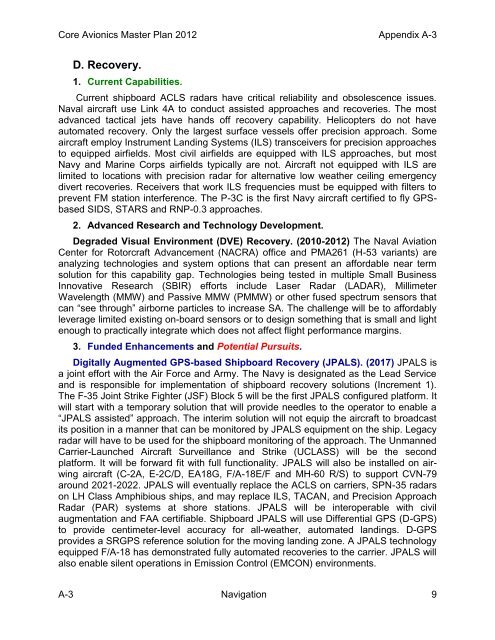PMA209 2012 Core Avionics Master Plan - NAVAIR - U.S. Navy
PMA209 2012 Core Avionics Master Plan - NAVAIR - U.S. Navy
PMA209 2012 Core Avionics Master Plan - NAVAIR - U.S. Navy
Create successful ePaper yourself
Turn your PDF publications into a flip-book with our unique Google optimized e-Paper software.
<strong>Core</strong> <strong>Avionics</strong> <strong>Master</strong> <strong>Plan</strong> <strong>2012</strong> Appendix A-3D. Recovery.1. Current Capabilities.Current shipboard ACLS radars have critical reliability and obsolescence issues.Naval aircraft use Link 4A to conduct assisted approaches and recoveries. The mostadvanced tactical jets have hands off recovery capability. Helicopters do not haveautomated recovery. Only the largest surface vessels offer precision approach. Someaircraft employ Instrument Landing Systems (ILS) transceivers for precision approachesto equipped airfields. Most civil airfields are equipped with ILS approaches, but most<strong>Navy</strong> and Marine Corps airfields typically are not. Aircraft not equipped with ILS arelimited to locations with precision radar for alternative low weather ceiling emergencydivert recoveries. Receivers that work ILS frequencies must be equipped with filters toprevent FM station interference. The P-3C is the first <strong>Navy</strong> aircraft certified to fly GPSbasedSIDS, STARS and RNP-0.3 approaches.2. Advanced Research and Technology Development.Degraded Visual Environment (DVE) Recovery. (2010-<strong>2012</strong>) The Naval AviationCenter for Rotorcraft Advancement (NACRA) office and PMA261 (H-53 variants) areanalyzing technologies and system options that can present an affordable near termsolution for this capability gap. Technologies being tested in multiple Small BusinessInnovative Research (SBIR) efforts include Laser Radar (LADAR), MillimeterWavelength (MMW) and Passive MMW (PMMW) or other fused spectrum sensors thatcan “see through” airborne particles to increase SA. The challenge will be to affordablyleverage limited existing on-board sensors or to design something that is small and lightenough to practically integrate which does not affect flight performance margins.3. Funded Enhancements and Potential Pursuits.Digitally Augmented GPS-based Shipboard Recovery (JPALS). (2017) JPALS isa joint effort with the Air Force and Army. The <strong>Navy</strong> is designated as the Lead Serviceand is responsible for implementation of shipboard recovery solutions (Increment 1).The F-35 Joint Strike Fighter (JSF) Block 5 will be the first JPALS configured platform. Itwill start with a temporary solution that will provide needles to the operator to enable a“JPALS assisted” approach. The interim solution will not equip the aircraft to broadcastits position in a manner that can be monitored by JPALS equipment on the ship. Legacyradar will have to be used for the shipboard monitoring of the approach. The UnmannedCarrier-Launched Aircraft Surveillance and Strike (UCLASS) will be the secondplatform. It will be forward fit with full functionality. JPALS will also be installed on airwingaircraft (C-2A, E-2C/D, EA18G, F/A-18E/F and MH-60 R/S) to support CVN-79around 2021-2022. JPALS will eventually replace the ACLS on carriers, SPN-35 radarson LH Class Amphibious ships, and may replace ILS, TACAN, and Precision ApproachRadar (PAR) systems at shore stations. JPALS will be interoperable with civilaugmentation and FAA certifiable. Shipboard JPALS will use Differential GPS (D-GPS)to provide centimeter-level accuracy for all-weather, automated landings. D-GPSprovides a SRGPS reference solution for the moving landing zone. A JPALS technologyequipped F/A-18 has demonstrated fully automated recoveries to the carrier. JPALS willalso enable silent operations in Emission Control (EMCON) environments.A-3 Navigation 9

















